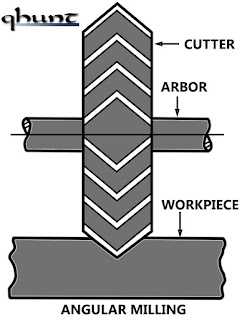There are 12 types of operations which can be performed on a Milling Machine. Large varieties of components are manufactured on a milling machine involving the below mentioned various types of operations. These different types of milling operations performed on a milling machine are mentioned below.
- Plain milling
- Face milling
- Side milling
- Straddle milling
- Angular milling
- Gang milling
- Form milling
- Profile milling
- Helical milling
- Cam milling
- Thread milling
- End milling
- Die Sinking
Plain Milling Operation
The
plain milling is the operation of producing of a plain, flat surface parallel
to axis of the milling cutter. The operation is also called slab milling. This
operation is carried out with the help of plain or slab milling cutter.
 |
| Plain Milling Operation |
Face Milling Operation
This
operation is performed by a face-milling cutter rotated about an axis
perpendicular to the work surface. The operation is carried in a plain milling
machine and the cutter is mounted on a stub arbor to produce a flat surface.
Side Milling Operation
The
side milling is the operation of production of a flat vertical surface on the
side of a work piece by using a side-milling cutter. The depth of cut is
adjusted by rotating vertical feed screw of table.
Straddle Milling Operation
The
straddle milling is the operation of production of flat vertical surfaces on
the both sides of a work piece by using two side milling cutters mounted on the
same arbor. The distance between the two cutters is correctly adjusted by using
suitable spacing collars.
Angular Milling Operation
Is
the operation of production of an angular surface on a work piece other than
right angles to the axis of milling machine spindle? The angular groove may be
single or double angle and may be of varying included angle according to the
type and shape of the angular cutter used.
Gang Milling Operation
This
is the operation of machining several surfaces of a work piece simultaneously
by feeding the table against a number of cutters having same or different
diameters mounted on the arbor of the machine.
Form Milling Operation
The
form milling is the operation of production of irregular contours by using form
cutters. The irregular contour may be convex, concave or of any other shape.
Profile Milling Operation
It
is a reproduction of an outline of a template or complex shape of a master die
on work surface.
Helical Milling Operation
It
is the operation of production of helical flutes or grooves around the
periphery of a cylindrical or conical work piece. Swivelling the table to the
required helix angle to performs the operation. Then by rotating and feeding
the work against rotary cutting edges of a milling cutter.
Cam Milling Operation
Cam-milling
is the operation of production of cams in a milling machine by the use of a
universal dividing head and a vertical milling attachment. The axis of the cam
blank and the end mill spindle should always remain parallel to each other when
set for cam milling.
Thread Milling Operation
The
thread milling is the operation of production of threads by using a single or
multiple thread-milling cutters. The operation is performed in a special thread
milling machines.
End Milling Operation
The
end milling is the operation of production of flat surface which may be
vertical, horizontal or at an angle in reference to the table surface. The
cutter used is an end mill.
Die Sinking Operation
Dies
for drop forging, die-casting and sheet metal forming have impression or
cavity. The operation of cutting this impression or cavity in the die is called
die sinking. A simple or plain type diesinker is similar in its general
arrangement to a vertical-milling machine. The cutters used are such which will
assist as far as possible obtaining whatever shape required for die cavity.
Many devices and attachments for die sinking machine have been designed to
eliminate chipping and other different hand operations. For example die-sinking
machine have been equipped with a ‘cherrying head’ for milling circular
impression in the dies. A die-sinking machine is known as universal type, is so
designed that both cherrying and straight die sinking operations can easily be
performed without special attachments or cutters.
Note - Cherrying relates to the operation
of milling circular or special impression in the dies. Routing is milling a
more or less irregular outline while guiding by hand.









No comments